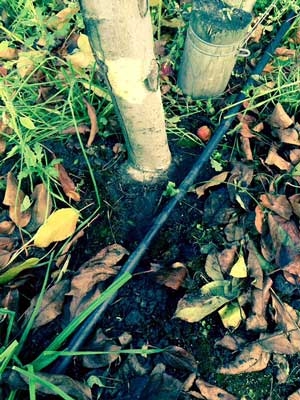Scion rooting is due to trees either being grafted too low in the nursery, or the tree being planted too low in the orchard.
The graft union being placed below the soil causes the variety to grow its own roots thus negating the effect of the rootstock (Figure 1).
Classic signs of this happening are:
- trees have far more vigour than the rest of the trees in a block
- trees have apples or pears on them that don’t colour as well or
- trees lose their leaves later in the season than the other trees of the same variety in the block.
Figure 2 shows the difference in the scion rooted tree. When this happens the fruit from these trees is very rarely as good in quality as the rest of the block—mostly due to the extra vigour in the trees.
With most of the dwarfing or semi dwarfing rootstocks it is fairly easy to see the graft union if it is above the soil (Figure 3).
Prevention better than cure
If you cannot see this union and the tree has one of the above symptoms, there is a high possibility that scion rooting is your problem.
It is a problem that is not easily rectified—especially if the tree has been scion rooted for several years.
It is certainly a case of prevention is better than the cure.
Girdling a possible remedy
One way that some try to remedy this problem is by girdling the tree every year to reduce vigour (Figure 4).
Get it right in the nursery
If you have a good working relationship with your nursery, let them know your minimum height above the ground for the graft.
If you are growing your own trees, never graft the rootstock lower just because you don’t have enough calliper in the rootstock—keep the graft at a constant height far enough above the soil so that scion rooting won’t happen when the tree is planted in the orchard.
Safe height
A safe height is usually at least 20 cm above the soil.
Don’t be scared to plant the tree fairly high in the soil if it has been grafted lower than you would like to see.
Leaf and weed litter around the butt of the tree can also encourage trees with the graft union close to the soil to initiate roots on the scion which don’t take long to grow down into the soil.
You have generally paid good money for the trees or rootstocks for your new block, don’t miss out on the benefits of the rootstock by not planting it right in the soil.
Common problem
This problem is extremely common and there are not many orchards that I have been to that don’t have this problem in at least one block if not all blocks.
For more information, contact Peter Morrison
For contact details and images, see Tree Fruit May2015






















